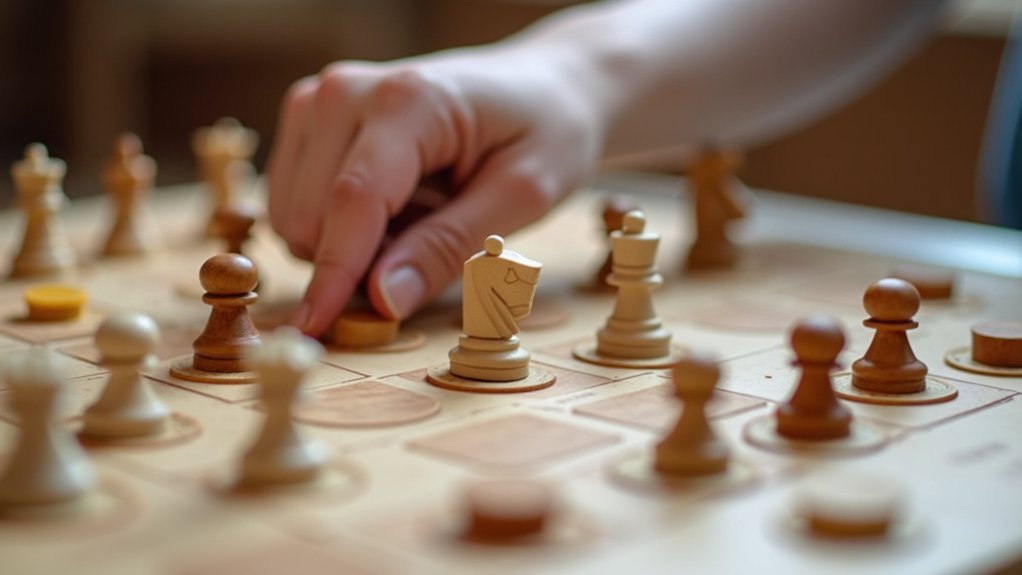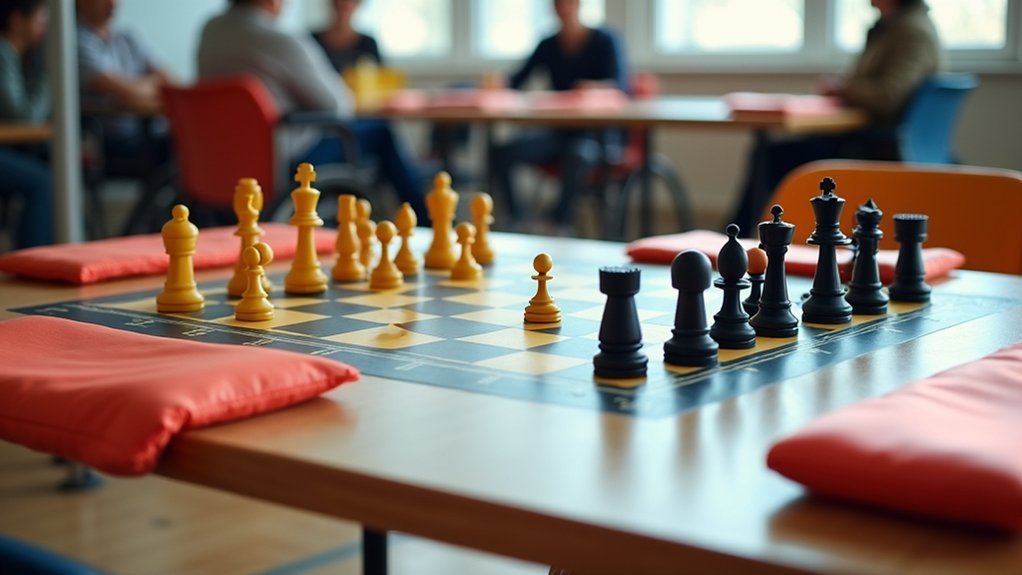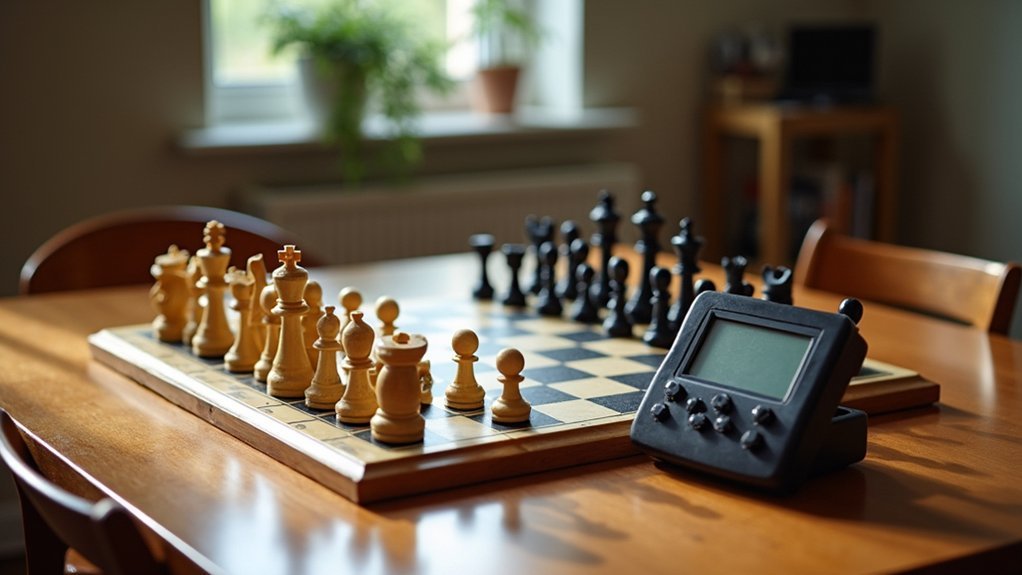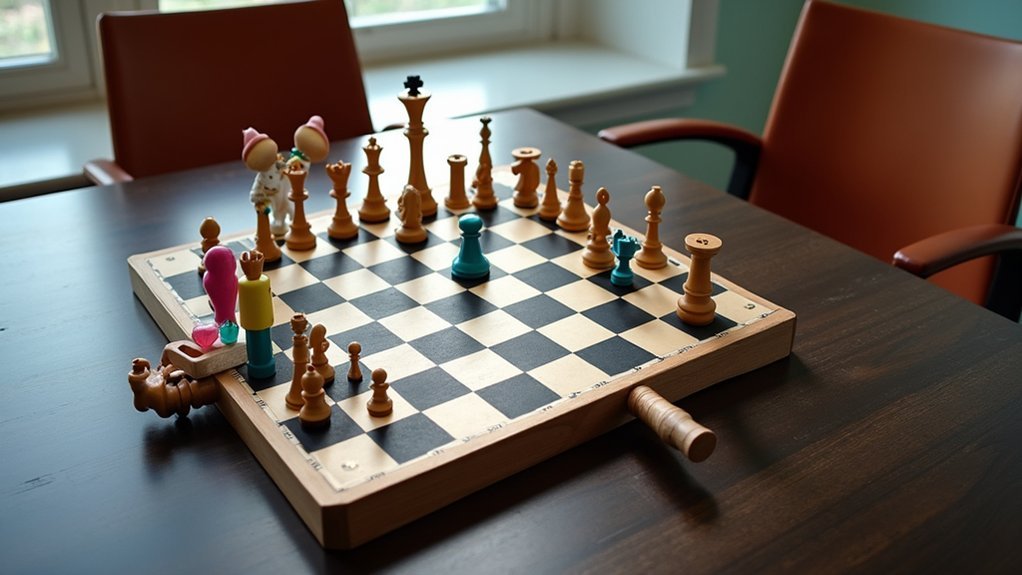Chess equipment for physical disabilities includes tactile boards with raised squares for visually impaired players, magnetic or peg-and-hole systems for stability, and custom 3D-printed pieces for different gripping needs. You’ll find voice-controlled apps, digital boards with sensor technology, and eye-tracking compatibility for hands-free play. Tournament protocols guarantee wheelchair accessibility with wider corridors and adjustable tables. These adaptive solutions make certain everyone can enjoy the royal game without limitations.
Tactile Chess Boards for Visually Impaired Players

Ingenuity transforms the game of kings into an accessible experience for visually impaired players through specially designed tactile chess boards.
These boards feature raised and recessed squares that allow players to differentiate positions by touch alone. White squares are typically elevated, helping users track diagonals and board colors.
Tactile elevation creates a mental map, transforming flat geometry into an accessible landscape navigated through fingertips.
Each piece is crafted with distinct textures and shapes—often with bumps on white pieces—making identification effortless. Small pegs on the bottom of pieces fit securely into holes on the board, preventing accidental movements during play. Premium sets offer enhanced peg fitting and refined tactile points compared to standard designs.
Many boards also include Braille coordinates along the edges for easier navigation.
You’ll find these boards in various materials, from durable wood combinations to easy-to-clean plastic.
The Tactum electronic board even connects via USB or Bluetooth to online platforms, bridging physical and digital chess communities.
Adaptive Chess Sets With Securing Mechanisms
Adaptive chess sets with securing mechanisms address one of the most frustrating challenges for players with physical disabilities—maintaining piece stability during play. These specialized designs guarantee pieces remain in place despite tremors, limited motor control, or accidental bumps. The design principles applied in these sets echo those created for visually impaired players, with tactile feedback being particularly important for both user groups.
| Mechanism Type | Benefits | Best For |
|---|---|---|
| Magnetic | Invisible security, easy movement | Travel, mild tremors |
| Peg and Hole | Maximum stability, tactile feedback | Severe motor issues |
| Weighted Pieces | Natural feel, moderate security | Slight mobility challenges |
| Smart Boards | Automated assistance, piece recognition | Tech-savvy players |
You’ll find these securing mechanisms enhance your concentration by eliminating the distraction of repositioning pieces. Whether you prefer magnetic attraction for subtle assistance or more robust physical restraints, these adaptive solutions allow you to focus on strategy rather than struggling with equipment stability.
Wheelchair-Accessible Tournament Setups

While securing chess pieces addresses individual gameplay challenges, creating inclusive tournament environments represents the next level of accessibility.
When organizing tournaments, you’ll need to guarantee at least one-third of the playing area has wide enough corridors for wheelchairs and walkers.
Assign boards flexibly based on players’ needs, considering table height and space requirements. Keep all players integrated in a common area rather than segregating those with disabilities.
Tables should accommodate assistants when needed, and board numbering should remain consistent to help players navigate the space. Corridors between tables should be twice as wide to ensure proper wheelchair access.
Encourage players to notify you of their needs in advance, allowing for collaborative planning.
Balance accommodation requirements with financial considerations while maintaining dignity for all participants.
Specialized Chess Equipment for Limited Mobility
When physical limitations affect a player’s ability to manipulate standard chess pieces, specialized equipment becomes essential rather than optional. Tactile chess sets with peg-and-hole systems prevent pieces from slipping while providing stability for those with limited dexterity.
For visually impaired players, boards with raised squares and pieces with distinct textures and Braille markings guarantee independent play. High-contrast, large-print boards accommodate those with low vision, while recessed squares add tactile navigation benefits. Chess pieces with metal tips help visually impaired players identify different pieces by touch.
Adaptive chess clocks feature oversized buttons that require minimal pressure, making them accessible even with limited hand strength. Custom 3D-printed pieces can be tailored to specific grip requirements, with lightweight materials reducing fatigue during extended play sessions.
Many designs prioritize portability with foldable boards and built-in storage, minimizing setup demands.
Custom Chess Pieces for Different Gripping Abilities

For players with diverse gripping capabilities, custom chess pieces represent a breakthrough innovation that brings the game to life.
3D printed pieces can be tailored with textured surfaces, wider bases, and finger indentations to match your specific hand dexterity needs. You’ll find lightweight materials like resin or plastic reduce fatigue while non-slip coatings prevent accidental moves.
Oversized pieces with exaggerated designs make handling easier if you have tremors or limited fine motor skills. Tactile differentiation through distinct markers, varied textures, and braille labels guarantees you can identify pieces by touch. Our chess sets for visually impaired users feature differentiation by color and texture with brown pieces for one player and light gray for the other.
Many sets now offer modular components that adapt to your changing physical requirements, with options to adjust height and weight for ideal control. These personalized designs emerge from collaborations with occupational therapists to guarantee truly accessible chess play.
Digital Chess Alternatives for Physical Limitations
If you’re unable to manipulate physical chess pieces, voice-controlled chess apps offer a hands-free way to enjoy the game.
Digital platforms like Lichess and Chess.com now feature keyboard shortcuts, voice commands, and eye-tracking compatibility to accommodate various physical limitations.
These accessible alternatives let you play chess independently, whether you prefer using Dragon NaturallySpeaking for voice control or a Tobii Eye Tracker for move selection with minimal physical effort. Chess.com is actively working to expand accessibility through voice move inputs to benefit players with mobility challenges.
Voice-Controlled Chess Apps
Although traditional chess requires physical manipulation of pieces, voice-controlled chess apps have revolutionized accessibility for players with physical disabilities. These apps enable complete gameplay without touching your device, allowing you to make moves, navigate menus, and adjust settings using only voice commands.
Apps like Verbal Chess offer extensive voice control that benefits users with limited hand mobility or those who need hands-free options.
One excellent option is Karuah Chess, which utilizes the powerful Stockfish engine for challenging gameplay across fifteen difficulty levels.
You’ll appreciate these key advantages:
- Full voice navigation through all screens and gameplay options
- Move announcement features that vocalize opponent moves for blindfold play
- Compatibility with screen readers and other assistive technologies
Whether you’re playing against AI or human opponents online, voice-controlled chess apps eliminate physical barriers while maintaining the complete chess experience, making the game accessible regardless of motor limitations.
Digital Board Accessibility
Digital chess boards represent a significant advancement for players with physical limitations, offering sophisticated alternatives to traditional wooden sets. These boards use sensor technology to track piece movements accurately, eliminating the need to physically manipulate pieces with precision. The Square Off technology features no press registration for piece movement detection, making it especially suitable for players with limited hand dexterity.
| Board Type | Key Features | Best For |
|---|---|---|
| DGT Boards | Sensor technology, online integration | Limited dexterity |
| Braille Boards | Tactile feedback, portable design | Visual impairments |
| Voice-Enabled | Voice commands, audio feedback | Multiple disabilities |
| AI-Integrated | Adjustable difficulty, solo play | Limited mobility |
| Multi-Input | Keyboard/voice controls, multilingual | Communication barriers |
You’ll find these boards connect seamlessly to online platforms, allowing you to engage with the global chess community without physical constraints. Many also integrate with assistive technologies, providing tactile feedback and voice announcements for enhanced accessibility.
Tournament Accommodation Protocols for Disabled Players

When participating in chess tournaments, players with disabilities can expect thorough accommodation protocols designed to guarantee fair and dignified competition.
Tournament organizers must comply with ADA requirements and FIDE guidelines while providing reasonable accommodations based on your specific needs.
You’ll typically arrange accommodations before the event through email or meetings. These details remain confidential, shared only on a “need-to-know” basis. Your experience will prioritize integration, not segregation.
- Personalized board assignments with extra space for wheelchairs or adaptive equipment
- Permission to use specialized equipment like braille boards or custom pieces
- Option to bring assistants or communication aids when necessary
Remember that tournaments handle accommodations case-by-case, ensuring each player receives appropriate support while maintaining competitive integrity and legal compliance.
It’s important to understand that accommodations provided must never give any player an advantage, as the fairness principle remains fundamental to competitive chess.
Frequently Asked Questions
What Is the Average Cost of Adaptive Chess Equipment?
You’ll find basic adaptive chess sets for $50-200, while advanced electronic and AI-enabled boards range from $200-900. Your total investment depends on specific needs—visual, motor, or cognitive adaptations greatly affect pricing.
Do Tournaments Provide Specialized Chess Equipment Upon Request?
Yes, many tournaments provide specialized chess equipment if you request it in advance. You’ll find organizers often accommodate needs like braille sets, securing apertures, and adaptive boards to guarantee inclusive participation.
How Long Does Custom Chess Equipment Typically Take to Manufacture?
Custom chess equipment typically takes 2-6 weeks to manufacture after design approval. You’ll wait longer for handmade items, while machine-produced pieces are faster. Rush orders are available from some manufacturers for additional fees.
Are There Rental Options for Specialized Chess Equipment?
Yes, you’ll find rentals for specialized chess equipment through adaptive recreation centers, specialty retailers, and event companies. They offer adaptive sets, tables, talking clocks, magnifiers, and giant chess rentals with delivery options available.
Can Adaptive Chess Equipment Be Used in Official Rated Matches?
Yes, you can use adaptive chess equipment in official rated matches. Both USCF and FIDE permit reasonable accommodations for disabilities, including specialized clocks, boards, and mechanical aids, as long as they don’t provide unfair advantages.
In Summary
You’ll find that chess truly is for everyone. Whether you’re using a tactile board, modified pieces, or digital alternatives, today’s adaptive equipment guarantees your physical limitations don’t limit your play. Don’t hesitate to request accommodations at tournaments either—chess organizers are increasingly committed to accessibility. With the right equipment tailored to your specific needs, you’re ready to call “checkmate” alongside any player.





Leave a Reply